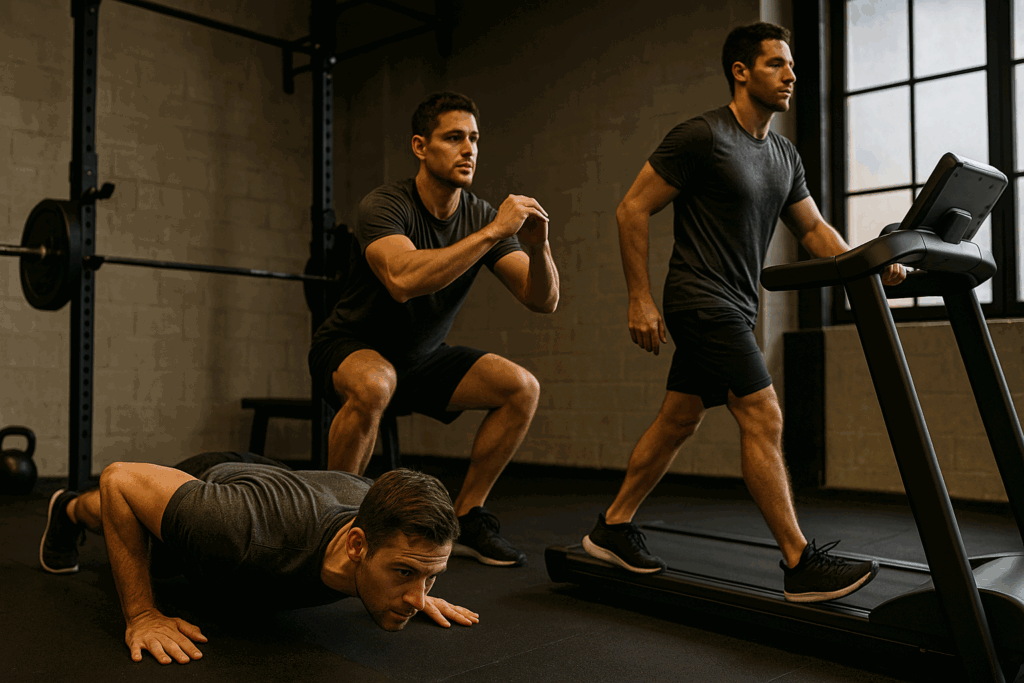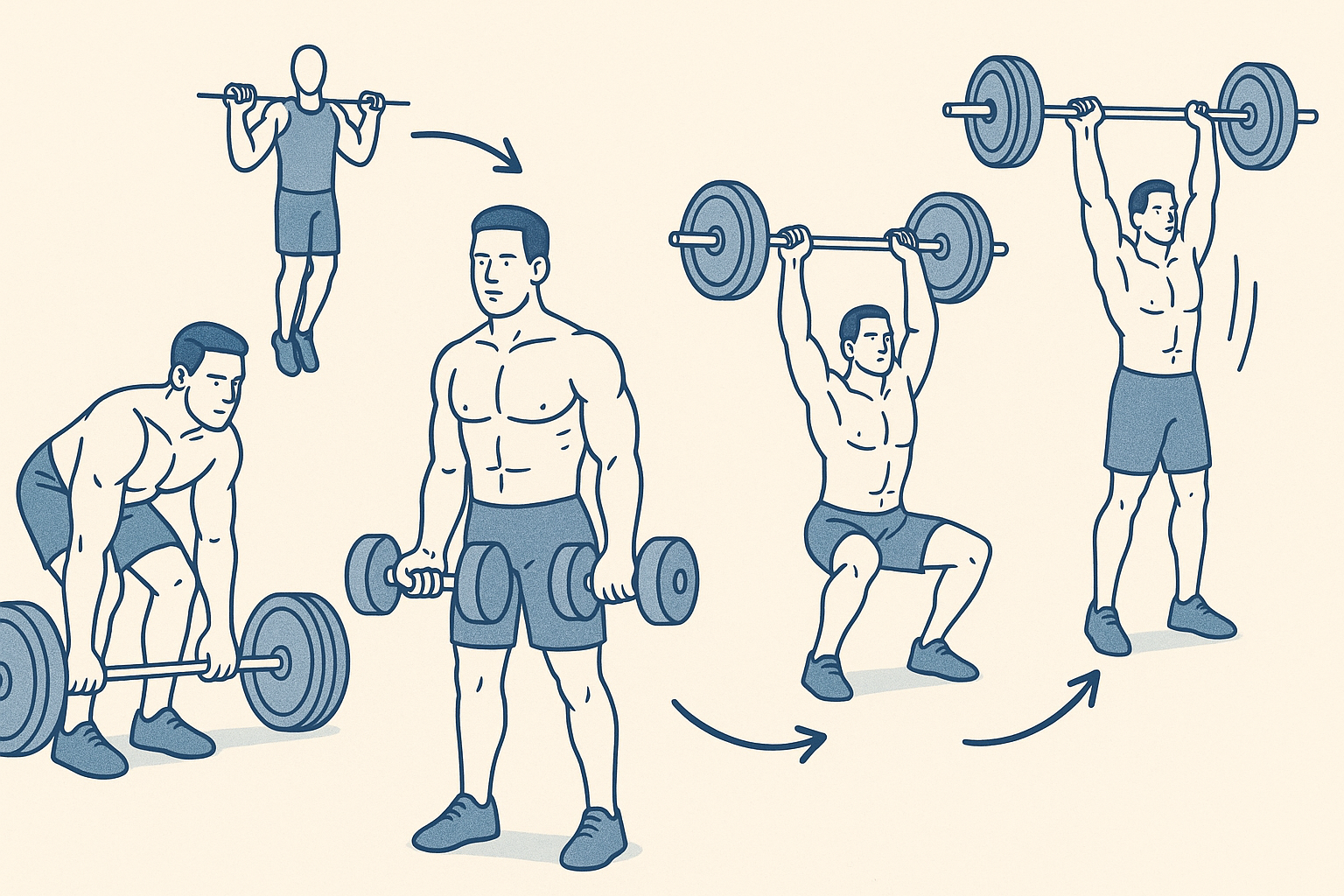The Ultimate 30-Day Workout Plan for Men: Powerful Full Body Strength Exercises to Transform Your Fitness
When it comes to men working out in the gym, consistency, structure, and scientific guidance are essential for achieving real, measurable results. A well-crafted fitness plan tailored to male physiology and training goals can lead to substantial improvements in muscular strength, endurance, and body composition. With the right program, even just 30 days can create powerful momentum toward long-term health and performance transformation. This guide presents the ultimate 30-day workout plan for men, combining foundational training principles, strategic exercise progressions, and time-tested strength exercises to optimize your results.
You may also like: Optimize Your Physique With Smart Nutrition: Harnessing Peptides for Muscle Growth and Fat Loss
Why a 30-Day Workout Plan for Men Works: The Science of Transformation
Thirty days might seem like a short window, but research supports that significant neural adaptations, muscular hypertrophy initiation, and cardiovascular improvements can occur in as little as four weeks. For men, these changes are often amplified by higher baseline testosterone levels and greater muscle fiber density, allowing them to respond more rapidly to resistance training stimuli. The best male workout routines leverage these physiological advantages while ensuring recovery, progression, and goal specificity are honored.
A structured 30 day workout plan for men creates a psychological framework that fosters discipline and momentum. When you have a clear schedule with daily goals and progressive overload principles baked in, you’re more likely to show up and put in quality effort. This helps you build habits that stick long after the 30 days are over. Additionally, using basic full body workout principles ensures that each training day targets multiple major muscle groups, which supports better hormonal response and metabolic adaptation.

Building the Foundation: What Every Guy Needs Before Starting a 30 Day Workout Routine for Men
Before diving into an intense workout plan for guys, it’s vital to assess your current fitness level, identify your goals, and set realistic expectations. Many men jump headfirst into training without understanding mobility limitations, prior injuries, or cardiovascular baselines, which can lead to frustration or injury. A foundational assessment may include body composition testing, movement screening (like the overhead squat test), and determining baseline strength using push-ups, planks, or a submaximal barbell test.
Nutrition and sleep cannot be overlooked when beginning a 30 day workout routine for men. High-quality protein intake, complex carbohydrates, and healthy fats support muscle growth, while consistent sleep cycles enhance recovery and hormonal regulation. Hydration also plays a major role in performance and recovery. Understanding these lifestyle pillars will allow you to get the most out of your full body gym workout for men while minimizing setbacks.
It’s also essential to set a clear purpose. Are you training for size, strength, general health, or athletic performance? Your answer determines the training split, volume, and intensity. For this guide, we blend hypertrophy, strength, and conditioning to create a well-rounded male gym workout plan.
Week One: Establishing Strength and Conditioning Foundations
In the first week of your 30 day workout schedule for men, the primary objective is to acclimate your body to consistent movement and stimulus. The training days alternate between strength training and cardiovascular conditioning, using a basic full body workout structure for efficiency and recovery. This allows the central nervous system to adapt and builds a base for more demanding sessions ahead.
Strength exercises for men in week one include foundational lifts such as squats, deadlifts, push-ups, pull-ups, and planks. These compound movements activate large muscle groups, stimulate testosterone production, and train motor patterns crucial for athletic performance. Conditioning days incorporate 20–30 minutes of moderate-intensity steady-state cardio like cycling or incline treadmill walking, boosting aerobic capacity without excessive joint stress.
Active recovery is key during this initial phase. Incorporating mobility drills, foam rolling, and light stretching ensures that your body remains flexible and prepared for upcoming workouts. Many guy workout routines skip recovery, but integrating it here pays dividends in weeks three and four when intensity rises.

Week Two: Progressing Toward Hypertrophy with Full Body Exercises for Men
As your body adapts to week one, week two introduces progressive overload to stimulate muscle growth. This includes increased weight, higher volume, and shorter rest periods between sets. The focus remains on full body exercises for men, with specific attention to movement quality and time under tension. Reps per set increase slightly, and tempo-controlled movements are introduced to maximize hypertrophy.
The best fitness exercises for men this week revolve around complex, multi-joint lifts like barbell lunges, overhead presses, bent-over rows, and Romanian deadlifts. These moves target major muscle groups while also engaging stabilizers and core musculature. To ensure metabolic demand, short supersets are integrated—for example, pairing squats with kettlebell swings or push-ups with battle ropes.
This phase also introduces metabolic conditioning (MetCon) workouts to complement resistance training. Exercises like sled pushes, box jumps, and kettlebell complexes are employed in circuit format. These sessions mimic real-world athletic scenarios, increasing both muscular endurance and mental grit.

Men Working Out in the Gym: Developing the Discipline for Strength and Results
Men working out in the gym often face the challenge of sustaining consistency beyond the initial burst of motivation. Week three of the 30 day workout plan for guys centers on establishing that deeper discipline. This week increases training frequency to five days, including three strength sessions and two high-intensity interval training (HIIT) workouts. Here, the routine truly begins to sculpt the body.
Weight workouts for men in week three are organized into push-pull splits. One day targets the upper body (chest, shoulders, triceps), another hits the lower body (quads, hamstrings, glutes), and a third focuses on posterior chain and back development. Exercises like weighted dips, barbell squats, chin-ups, and T-bar rows dominate the lineup. The volume is high, but careful programming ensures each muscle group gets sufficient recovery.
For conditioning, the HIIT sessions feature 20 seconds of maximum-effort work followed by 40 seconds of active rest. This format is proven to boost VO2 max, insulin sensitivity, and calorie expenditure. Exercises include rowing, sprint intervals, burpees, and medicine ball slams. By this stage, you’ll start to see noticeable physical changes—reduced body fat, improved muscle tone, and better energy throughout the day.

Strategic Recovery: Balancing Intensity with Restoration
With the elevated training demands in week three, the importance of intelligent recovery becomes even more critical. Recovery is not merely about taking a day off—it’s about giving your body the tools it needs to repair and rebuild stronger. In your 30 day workout routine for men, recovery practices should be as intentional as training.
Recovery days in this program include mobility flows, guided stretching sessions, and low-intensity activities such as walking or swimming. Sleep remains a cornerstone—aim for 7 to 9 hours per night. Nutritional focus should shift slightly toward increasing antioxidant-rich vegetables, omega-3 fatty acids, and hydration levels to combat inflammation and oxidative stress.
Supplementation may also support this recovery process. Creatine monohydrate aids in replenishing ATP stores, while branched-chain amino acids (BCAAs) can help reduce muscle soreness. These evidence-based interventions allow men to train harder without overreaching—a key factor for long-term success in workout programs for men.

Week Four: Maximizing Output with Advanced Strength Training for Men
The final week of your 30 day workout plan for men is all about consolidation and peak performance. Now that your body has adapted to frequency and volume, this week intensifies the challenge by introducing advanced training techniques like drop sets, pyramid sets, and contrast training. The goal is to push physical boundaries while reinforcing proper mechanics and mental resilience.
Strength training for men this week includes some of the best full body workout for men strategies: deadlift-to-pull-up supersets, squat-to-press complexes, and loaded carries. These combinations deliver maximum muscular engagement and cardiovascular output in one efficient package. Expect to train five to six times this week, with strategic variation in movement patterns to avoid overuse.
Your conditioning work should now mimic real-world performance. Sprint circuits, agility drills, and sandbag carries are highly functional and elevate your anaerobic threshold. Additionally, this is the ideal time to assess progress—retest your initial benchmarks and take note of strength gains, endurance improvements, and physical transformation.

Focus and Performance for Men Working Out in the Gym
Men working out in the gym during week four often experience a powerful mental shift. The body is stronger, yes—but the real change is in how the training is approached. Mental sharpness, focus, and resilience begin to dominate each session. This is where peak performance emerges, not just from lifting more weight, but from mastering form, timing, breathing, and effort.
The best workout for guys in this final phase is one that challenges both body and mind. Heavy lifts are combined with stability drills, such as Turkish get-ups or single-leg squats, forcing full-body coordination and proprioception. Practicing mindful lifting, with attention to breath and tempo, enhances neural drive and reduces injury risk.
To truly optimize gains in this final stretch, consider implementing contrast showers, sauna sessions, or sports massages. These tools improve circulation and aid in muscle recovery. The gym becomes not just a place to train, but a personal laboratory for exploring limits and capabilities.
Sustaining Results Beyond the 30 Day Workout Plan for Men
Once the 30 days are complete, the key challenge becomes sustaining momentum. Transformation doesn’t end here—it evolves. Many male home workout or gym workout man enthusiasts fall into the trap of regression by lacking a post-program strategy. The best male workout plans transition smoothly into maintenance or advanced phases.
Create a habit of weekly planning to sustain your gains. Rotate through similar strength splits, add variation in tempo, or try new modalities like CrossFit, calisthenics, or functional training. Track performance metrics like load lifted, rest times, and heart rate recovery to stay accountable. Implement deload weeks every 4 to 6 weeks to prevent burnout.
Nutrition strategies should also evolve. Now that you’ve built muscle and lost fat, recalibrate your caloric intake to maintain lean mass. Add strategic refeeds if you’re on a deficit, or taper back slightly if bulking. Lifestyle factors—sleep, stress management, and hydration—remain as essential now as they were on day one.
Frequently Asked Questions: The Ultimate 30-Day Workout Plan for Men
1. What Are the Psychological Benefits for Men Working Out in the Gym Daily?
Regular gym workouts offer more than just physical transformation—they catalyze mental resilience, discipline, and stress regulation. The consistency required in a 30 day workout plan for men establishes neural routines that can enhance mood stability, reduce symptoms of anxiety, and support emotional control. For men working out in the gym, the ritual itself becomes a form of mental training, often replacing negative habits with constructive self-investment. Studies have shown that structured strength training can increase dopamine and serotonin levels, reinforcing a sense of reward and well-being. Additionally, goal setting and physical progress can boost confidence and decision-making skills in professional and personal life.
2. How Can Busy Professionals Adapt a 30 Day Workout Routine for Men?
Time constraints are common, but efficiency-focused training can still yield results. A basic full body workout using compound lifts like squats, push presses, and deadlifts provides maximal muscle engagement in minimal time. For busy individuals, three 45-minute sessions per week can simulate much of the workload seen in a 30 day workout schedule for men. Incorporating resistance bands and kettlebells at home also enables quick transitions between exercises without wasting time on equipment setup. Even adopting a hybrid male home workout that alternates gym and at-home sessions can maintain progress when work schedules are tight.
3. What Role Does Sleep Play in a Male Gym Workout Transformation?
Sleep is often overlooked but is arguably as critical as training itself. During deep sleep, muscle tissue undergoes repair, growth hormone levels peak, and metabolic functions regulate. A man workout strategy that includes intense strength sessions without sufficient sleep may lead to cortisol spikes, impaired recovery, and plateaued gains. For those following weight workouts for men, aiming for 7–9 hours of quality sleep each night can dramatically improve strength retention and fat loss. Sleep hygiene practices—such as consistent bedtime, avoiding blue light, and magnesium intake—can support deeper rest and amplify the benefits of strength training for men.
4. What Makes the Best Full Body Workout for Men Effective?
The best full body workout for men stimulates all major muscle groups while incorporating varied movement planes, tempos, and rep ranges. Functional exercises like lunges with rotation, renegade rows, and weighted carries enhance strength, mobility, and core engagement in one session. Unlike isolated routines, full body gym workout for men formats ensure that muscular imbalances are addressed, reducing injury risks. The most effective guy workout routine includes push-pull supersets, unilateral loading, and finishers that tap into both aerobic and anaerobic systems. Variety within consistency—changing intensity but keeping movement patterns—produces optimal long-term results.
5. How Do Nutritional Strategies Evolve During a 30 Day Workout Plan for Guys?
Nutrition must shift dynamically to meet the demands of a 30 day workout plan for guys. During weeks one and two, caloric intake may need to increase slightly to support neural adaptation and glycogen replenishment. As intensity builds in weeks three and four, protein distribution becomes vital—aiming for 1.6 to 2.2g/kg of body weight spaced across four meals optimizes hypertrophy. Micronutrients like magnesium, zinc, and B-vitamins help regulate muscle contractions and hormonal balance. Hydration with electrolytes, particularly in hot climates or after HIIT, prevents cramping and fatigue. In many advanced workout programs for men, carb cycling is also introduced to match training demands with fuel availability.
6. Best Recovery Techniques for Men Working Out in the Gym Intensely
When men working out in the gym experience soreness and central fatigue, recovery must go beyond passive rest. Active recovery techniques like contrast showers, myofascial release, and dynamic stretching accelerate blood flow and aid toxin clearance. Cold-water immersion post-leg day has been shown to reduce inflammation, while infrared sauna sessions stimulate parasympathetic recovery. For strength exercises for men, incorporating massage gun therapy between high-intensity sessions can reduce delayed onset muscle soreness (DOMS). Nutritional support, particularly omega-3s and turmeric, provides an anti-inflammatory advantage during these peak weeks of training.
7. How Should the 30 Day Workout Schedule for Men Be Adjusted for Beginners?
For newcomers, the full 30 day workout schedule for men may require scaled programming to prevent overtraining and build foundational strength. Starting with a simple full body workout performed three times weekly allows the body to acclimate to resistance and movement demand. Gradually increasing volume, not intensity, should be the priority for the first two weeks. Beginners can also benefit from using machines before progressing to free weights, improving control and form without the risk of imbalance. Flexibility work should also be integrated early to support joint mobility and reduce injury risk, especially in lower body sessions.
8. How Do Hormones Affect the Results of a 30 Day Workout Plan for Men?
Hormonal response is a crucial yet underexplored aspect of any male workout regimen. Resistance training elevates anabolic hormones like testosterone and growth hormone, which directly influence muscle protein synthesis and recovery. The best workout exercises for men intentionally leverage compound lifts that engage large muscle groups, amplifying this endocrine response. However, chronic stress or poor sleep can increase cortisol, which counteracts these benefits by promoting fat storage and muscle breakdown. Supporting hormonal balance with adaptogens like ashwagandha or natural sunlight exposure can create a physiological environment conducive to growth throughout a 30 day workout routine for men.
9. What Are the Long-Term Psychological Effects of Completing a Full Body Gym Workout for Men?
Achieving consistency through a 30 day workout plan for men can significantly alter a man’s psychological landscape. Beyond visible changes, the process cultivates identity shifts—from someone attempting fitness to someone who lives fitness. The gym becomes a place of emotional regulation, mental clarity, and goal orientation. Many men experience reduced symptoms of depression and enhanced cognitive function, thanks to increased neurotrophic factors released during intense strength training for men. Moreover, success in fitness often translates into other domains—career, relationships, and confidence—as self-discipline and self-efficacy improve.
10. Can a Male Home Workout Be as Effective as a Gym Routine?
With intentional design, a male home workout can rival many gym-based routines, especially in terms of metabolic conditioning and mobility. By incorporating minimal equipment—resistance bands, adjustable dumbbells, TRX systems—men can target all muscle groups effectively through progressive overload. The key is creative programming: supersets, tempo changes, and movement variation maintain challenge and adaptation. While the body man gym setup may offer heavier loads and machine diversity, home workouts can emphasize time-under-tension and unilateral training for excellent results. For men unable to access a gym consistently, alternating between gym workout man plans and home-based sessions preserves continuity and minimizes training gaps.
Conclusion: Your 30 Day Workout Schedule for Men—A Blueprint for Lifelong Strength
This 30 day workout plan for men isn’t just about improving physical appearance; it’s a powerful primer on how to take control of your health, performance, and discipline. From the first foundational movement to the final sprint, each phase builds on the last to create a system that’s sustainable, effective, and challenging. Whether your goal is to master bodyweight movements, lift heavier loads, or simply improve your energy and vitality, this plan gives you the structure and momentum to succeed.
Through expert-backed strength training exercises for men, practical recovery methods, and advanced training progression, the 30-day commitment lays the groundwork for months—or even years—of athletic development. The transformation experienced by men working out in the gym during this plan goes beyond physique; it empowers confidence, sharpens focus, and cultivates resilience.
In a world full of quick fixes, this is your opportunity to build real strength the right way. Commit fully, follow through with intention, and you’ll walk out of these 30 days not just looking better, but performing—and living—at your peak.
Further Reading:
Workout Routines for Men: The Ultimate Guide
Ultimate Workout Routine for Men (Tailored for Different Fitness Level)
The 4-Week Full-Body Workout Will Help You Build Balanced Fitness





